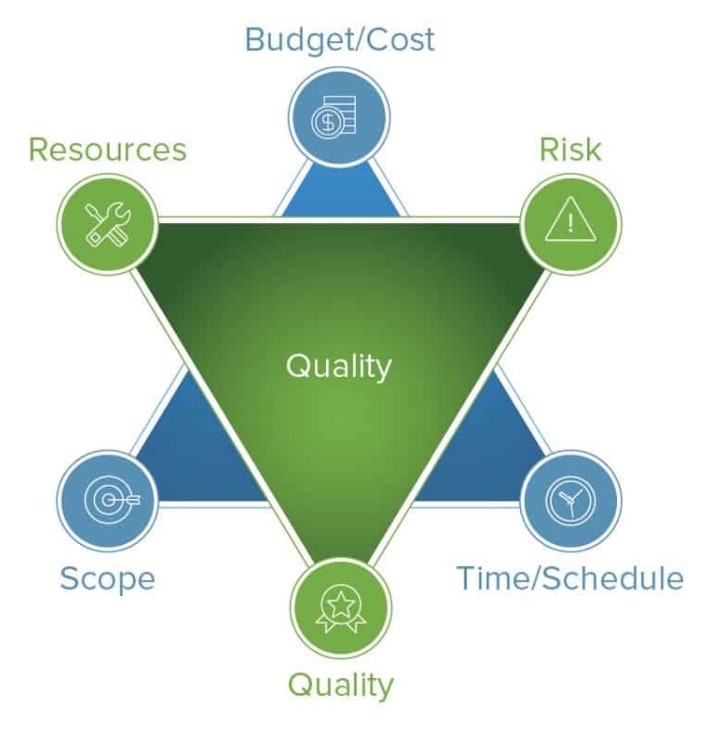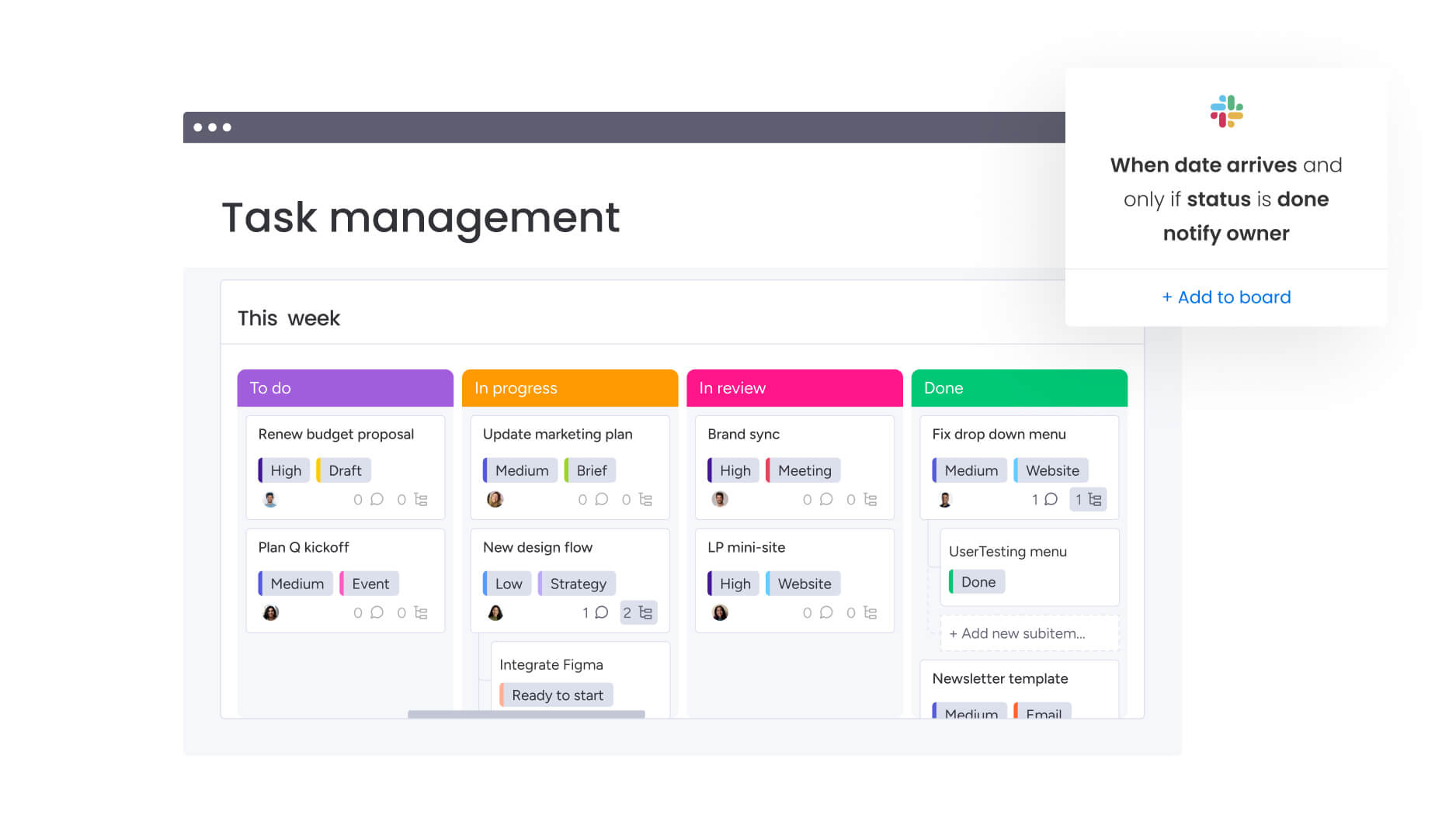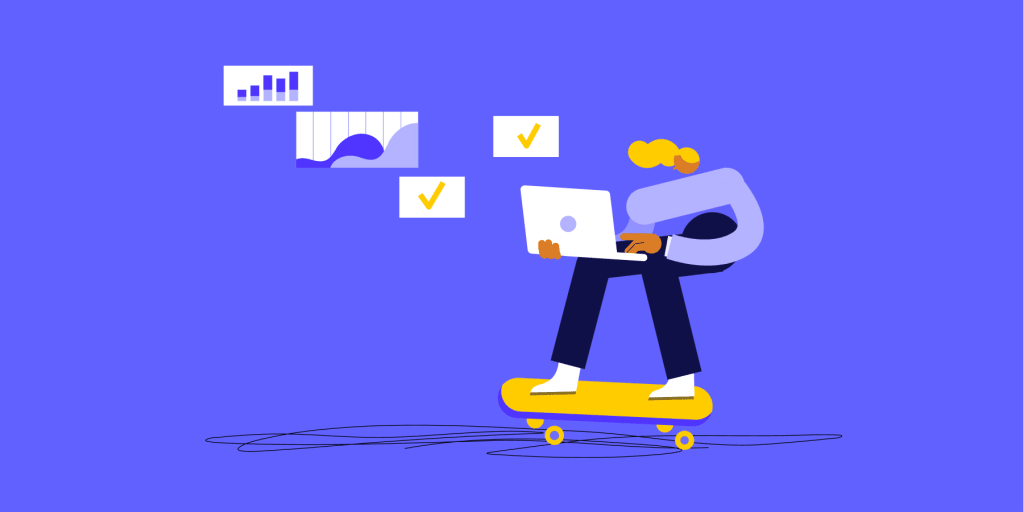Every project operates within limits. Budgets, timelines, and resources rarely stretch as far as teams would like — yet true project success depends on how effectively those constraints are managed, not avoided. The ability to deliver great work under real-world conditions is what distinguishes high-performing teams from those that struggle to stay aligned.
Project constraints define the boundaries of what can be achieved and the trade-offs required along the way. Understanding them turns potential obstacles into decision-making tools, helping leaders balance scope, cost, quality, and strategic priorities with clarity and control.
This post dives deep into the six critical project constraints to manage in 2025, from the classic triple constraint to newer dimensions like risk and stakeholder alignment. Learn how structured visibility, clear communication, and modern work management practices transform constraints into opportunities for smarter, faster execution.
Key takeaways
- Constraints as catalysts: constraints drive focus and innovation by turning boundaries into creative opportunities instead of limitations.
- Understanding the triple constraint: time, cost, and scope remain the core project variables — adjusting one inevitably affects the others, making proactive management essential.
- Expanding beyond the basics: modern projects face six critical constraints including resources, quality, risk, compliance, strategic alignment, and sustainability.
- Smarter visibility with monday work management: visual dashboards and AI-powered insights centralize constraint tracking, helping teams anticipate issues and align decisions with business outcomes.
- Adaptive management: transparent communication and flexible workflows enable teams to navigate trade-offs confidently, keeping projects stable even as constraints evolve.
What are project constraints in project management?
Project constraints are the fixed limitations that define how a project can be planned and executed. These non-negotiable boundaries, such as budgets, timelines, or available resources, determine what can realistically be achieved and how teams must prioritize their efforts.
Understanding these limits allows project managers to make informed trade-offs, balancing competing demands while keeping delivery on track. Each constraint affects the others, so managing them together is key to maintaining control and alignment.
The most common project constraints include:
- Time: hard deadlines that determine the pace of work.
- Budget: financial limits that define spending boundaries.
- Resources: available people, equipment, and materials.
- Scope: the specific deliverables and outcomes required.
- Quality: the minimum standards that must be met.
- Risk: the level of uncertainty the organization is willing to accept.
Constraints vs risks: understanding the key differences
Constraints and risks often get confused, but they’re fundamentally different.
In simple terms, constraints are known limitations you must accept whereas risks are potential problems that might happen.
Here’s how they differ in practice:
- Constraints are certain: your budget is $100,000 (that’s fixed).
- Risks are uncertain: you might go over budget if material costs increase.
- Constraints shape planning: you design your project around them.
- Risks require contingencies: you prepare backup plans in case they occur.
How constraints shape project success
Constraints aren’t obstacles, they’re guardrails that drive focus and innovation. When you know your boundaries, you can channel energy into finding creative solutions, a principle closely tied to the theory of constraints, instead of chasing endless possibilities.
Without constraints, projects often spiral out of control with endless feature additions, ballooning budgets, and meaningless deadlines. In fact, research shows only 23% of companies consistently deliver projects on time and within budget. Well-defined constraints force the prioritization needed to create focus and order.

The triple constraint model of project management
The triple constraint model is the foundation of project management, also known as the project management triangle. It reveals how time, cost, and scope connect like three sides of a triangle. Change one side, and the others must adjust.
This relationship drives every project decision you make. Need to deliver faster? You’ll either spend more money or reduce scope. Want more features? Expect to extend timelines or increase budget.
Time constraints
Time constraints are your fixed deadlines and schedule limitations, which also form a crucial part of the triple constraint. These might be market launch dates, regulatory deadlines, or seasonal windows you can’t miss.
When time is your primary constraint, everything else becomes negotiable. You might hire extra resources or cut features to hit the date. Platforms such as monday work management can really help you visualize these time pressures through Gantt charts and timeline views, making item dependencies visible before they become blockers.
Cost constraints
Cost constraints define your financial boundaries. A well-structured project budget can help you manage direct costs like salaries and materials, plus indirect costs like overhead and lost opportunities.
Budget limits force tough choices. Do you hire senior experts who work faster, or junior team members who cost less? Do you buy premium tools or build workarounds? These decisions shape your entire project approach.
Scope constraints
Scope constraints prevent your project from expanding beyond its original purpose. They define what you will deliver — and equally important, what you won’t.
Clear scope boundaries protect you from the endless “just one more feature” requests that derail projects. They give you permission to say no when stakeholders ask for additions that would compromise your core objectives.
6 critical project constraints that drive business impact
Modern projects face constraints beyond the traditional triple constraint. These additional factors often determine whether projects deliver real business value or just tick boxes.
1. Resource constraints
Effective resource management extends beyond simply having enough people on a project: it requires every asset to deliver outcomes effectively, from skills and tools to information access. Managing these constraints well ensures work stays balanced and teams can perform at their best.
Key resource types include:
- Human resources: not just headcount, but the right mix of skills and experience.
- Physical resources: equipment, facilities, and infrastructure availability.
- Information resources: access to accurate data, documentation, and expert knowledge.
Visibility is essential for managing all three. A connected platform such as monday work management provides real-time insight into capacity and allocation, helping leaders prevent overload, identify shortages early, and ensure resources are deployed where they add the most value.
2. Quality constraints
Quality constraints set the minimum acceptable standards for your deliverables. These aren’t nice-to-have goals — they’re pass/fail requirements that protect your reputation and ensure customer satisfaction.
Quality constraints might include performance benchmarks, compliance certifications, or user experience standards (they’re non-negotiable, regardless of time or budget pressure).
3. Risk constraints
Risk constraints define how much uncertainty your organization will tolerate. Every company has different risk appetite based on their industry, culture, and strategic position.
A start-up might accept high risk for rapid growth. A healthcare company might prioritize safety above all else. Understanding your risk constraints helps you make appropriate decisions about methodology and contingency planning.
4. Compliance and regulatory constraints
Regulatory requirements create immovable constraints that you must build into your project from day one. These vary by industry but might include:
- Healthcare: HIPAA privacy requirements.
- Finance: SOX compliance for public companies.
- Manufacturing: environmental and safety standards.
Ignoring these constraints doesn’t just risk project failure — it can result in fines, lawsuits, or criminal charges.
5. Strategic alignment constraints
Strategic constraints ensure your project supports broader business goals. They prevent you from optimizing locally while harming the organization globally.
These constraints might limit technology choices to approved vendors, require specific partnership arrangements, or mandate alignment with company values. They keep projects connected to long-term vision rather than short-term wins.
6. Sustainability constraints
Environmental and social responsibility requirements increasingly influence project decisions. These constraints might limit material choices, require carbon offset calculations, or mandate fair labor practices throughout your supply chain.
Forward-thinking organizations see these as opportunities to build competitive advantage while doing the right thing.
How project constraints fuel innovation and performance
Here’s a counterintuitive truth: constraints make you more creative, not less. When you have unlimited options, you waste time exploring dead ends. When you have clear boundaries, you focus on what matters.
The Apollo 13 mission proved this dramatically. Faced with life-or-death constraints on power, oxygen, and materials, the team invented solutions no one imagined possible. Those innovations happened because of constraints, not despite them.
What happens without constraints? Projects meander. Teams gold-plate features nobody asked for. Decisions get delayed because every option seems equally valid. Resources scatter across too many priorities.
Intuitive platforms like monday work management help you harness constraint power through automated rules and visual boundaries. Set budget alerts, timeline warnings, and resource limits that guide decisions without creating bureaucracy.

7 strategies to master project constraint management
Effective constraint management separates reactive teams from those that deliver consistently under pressure. When handled strategically, constraints provide clarity, sharpen focus, and guide better decision-making across every stage of a project.
Success comes from balancing flexibility with structure. The strategies below outline how to prioritize what matters most, communicate trade-offs clearly, and maintain control even as conditions shift.
1. Prioritize constraints based on business impact
Not all constraints matter equally. Focus your energy on the ones that directly affect business outcomes:
- Revenue impact: which constraints could delay market entry or reduce sales?
- Customer impact: which affect user experience or satisfaction?
- Strategic impact: which could derail long-term objectives?
This prioritization guides trade-off decisions when constraints conflict.
2. Build adaptive workflows for flexibility
Create project structures that bend without breaking when constraints shift. A well-designed project planning process ensures you can use modular approaches where you can adjust one component without rebuilding everything.
Features within platforms like monday work management can really help here: customizable boards let you modify workflows instantly, while you can also reassign work or change timelines without disrupting what’s already in motion.
3. Communicate trade-offs transparently
When constraints force difficult choices, present them in business terms stakeholders understand. Don’t say “we can’t do X because of technical limitations.” Say “doing X would delay launch by three weeks and risk missing the holiday season.”
Transparent communication builds trust and helps stakeholders make informed decisions, yet this can be a challenge in complex environments where research shows only 61% of employees in large enterprises are satisfied with transparency.
4. Leverage real-time dashboards for visibility
Visibility is the foundation of effective constraint management. Yet more than 60% of organizations say they lack real-time insight into project performance, making it difficult to spot issues before they escalate.
Dynamic dashboards bring clarity by surfacing constraint data across projects and portfolios, helping leaders see where capacity, budget, or timing pressures are building.
With connected dashboards in monday work management, that visibility becomes effortless:
- Executives get an instant view of overall portfolio health.
- Managers can drill into specific bottlenecks or risks.
- Teams see how their daily work contributes to broader organizational goals.
5. Automate constraint monitoring and alerts
Manual constraint tracking fails as projects scale. Set up automated systems that watch thresholds and notify you before problems occur.
Configure alerts for approaching deadlines, budget limits, or resource conflicts. Let the system handle routine monitoring while you focus on strategic decisions.
6. Develop smart contingency plans
Prepare for constraint changes before they happen. A comprehensive risk management plan helps you build decision trees that guide rapid response when circumstances shift:
- If timeline shrinks: which features get cut first?
- If budget reduces: where can you save without compromising quality?
- If resources leave: who provides backup coverage?
Having these plans ready accelerates decision-making under pressure.
7. Implement continuous review cycles
Finally, keep in mind that constraints evolve as projects progress and business conditions change. Schedule regular reviews to ensure your constraint management stays current.
Review frequency depends on project pace — weekly for rapid initiatives, monthly for longer efforts. Focus on what’s changed and what adjustments you need.

Scale constraint management with monday work management
As organizations grow, constraint management becomes exponentially more complex. Multiple projects compete for the same resources. Dependencies cross departments. Trade-offs affect entire portfolios.
monday work management transforms this complexity into a single source of truth through connected, intelligent systems that scale with your needs.
Visualize constraints across your portfolio
See every project’s constraint status in one unified view. Portfolio dashboards show which projects are at risk, where resources are overallocated, and how constraints interact across initiatives.
This bird’s-eye view enables strategic decisions about where to invest effort and how to balance competing priorities. Leaders can spot patterns and prevent systemic issues before they cascade.
AI-powered insights for proactive management
Artificial intelligence transforms constraint management from reactive to predictive. Instead of waiting for problems to surface, AI tools analyze performance data and flag issues before they impact delivery.
Within monday work management, intelligent features help teams stay ahead by:
- Analyzing project patterns: AI Blocks detect trends that signal potential constraint violations.
- Monitoring in real time: digital Workers continuously track project data and highlight emerging risks.
- Optimizing performance: the Risk Management Power-Up identifies and mitigates constraint-related challenges across multiple projects at once.
These AI-driven insights give leaders the foresight to make confident adjustments and maintain control under pressure.
Streamline risk management with dedicated features
Take control of project uncertainties with monday’s comprehensive risk management tools. The Risk Register template lets you categorize, prioritize and track potential obstacles in real-time, while automated risk scoring helps teams focus on what matters most.
Convert identified risks into actionable mitigation plans with assignable owners and clear timelines. Dashboards visualize risk exposure across projects, giving stakeholders immediate insight into where constraints might be threatened by emerging challenges.
Extend constraint management through powerful integrations
Managing constraints effectively requires connected systems that share data in real time. Integrations ensure that financial limits, timelines, and resource data remain consistent across every tool your teams use.
With monday work management, over 200 integrations keep constraint data aligned across your entire ecosystem:
- Financial systems: link ERP or accounting tools to track budget constraints accurately.
- Scheduling platforms: sync with Google Calendar or Outlook to maintain up-to-date deadlines.
- Time tracking tools: connect apps like Harvest to monitor effort and capacity in real time.
- Development environments: integrate with Jira or GitHub to manage technical dependencies seamlessly.
Connect constraints to strategic objectives
Link every constraint decision to business outcomes. When you connect project limitations to strategic goals, trade-offs become more defined and stakeholder alignment improves, which is critical given that employees who understand how success is measured are twice more likely to feel motivated.
monday work management makes these connections visible through linked boards and cross-project dependencies. Everyone understands not just what constraints exist, but why they matter for business success.
Frequently asked questions
What is the difference between project constraints and project assumptions?
Project constraints are the fixed limits you must operate within, such as a set budget of $50,000 or a delivery deadline. They define the boundaries of what’s possible in your project.
How can constraints be used to help define the problem more effectively?
Constraints create clear boundaries that make problems more specific and solvable. When you know you have only three developers for six months, you can define realistic project scope instead of planning for unlimited possibilities. These boundaries force precision in problem definition.
What happens when project constraints conflict with each other?
When constraints conflict, stakeholders must choose which to prioritize. If you can’t extend timeline or increase budget but need more features, something must give — otherwise, scope creep becomes almost inevitable. Document the trade-offs with specific details, showing the business impact of each option to enable informed decisions.
How do you document project constraints for stakeholder communication?
Effective constraint documentation includes the constraint description, business impact, owner, and monitoring method. Use visual dashboards that show constraint status at a glance, with drill-down capability for details. Update regularly and make accessible to all stakeholders.
Which project constraint typically has the greatest impact on project success?
Time constraints often drive the most critical decisions because they’re usually the least flexible. Market windows close, regulatory deadlines pass, and competitive advantages disappear. However, the most impactful constraint varies by project context and business priorities.
How often should project teams review and update constraint assessments?
Review constraints at every major milestone and decision point. For fast-moving projects, this might be weekly. For longer initiatives, monthly reviews work well. Increase frequency during high-uncertainty periods or when external factors change rapidly.
